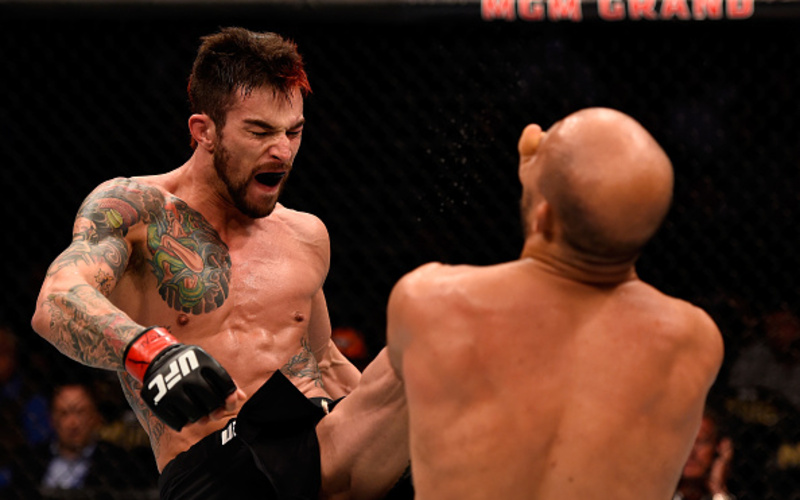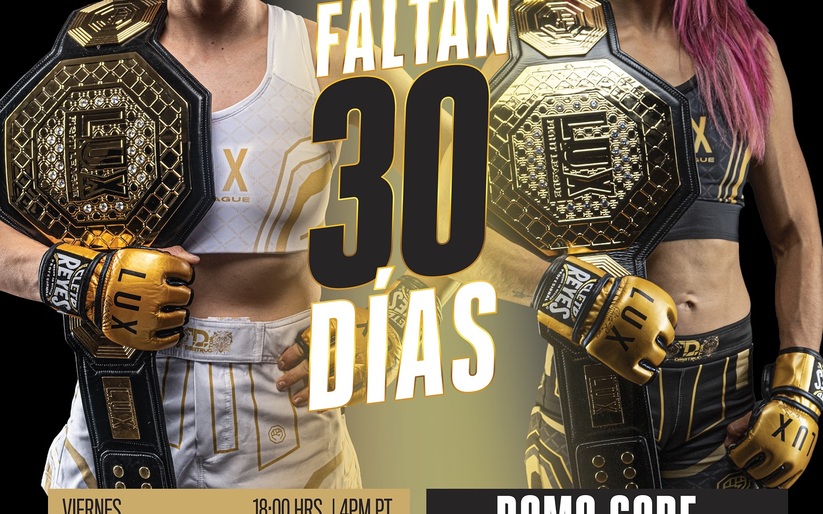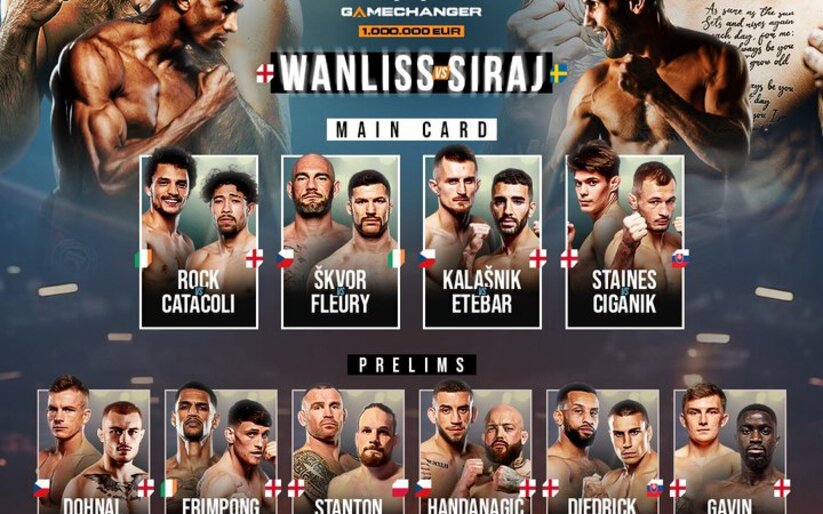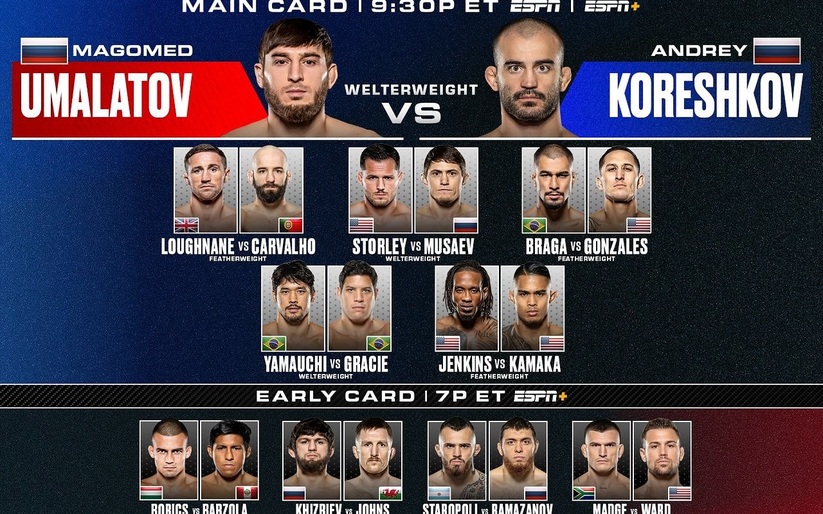It’s been over three years since we last saw fizzled prospect, Brandon Thatch. Thatch has been a favorite of mine since his fight against Benson Henderson. However, Thatch would disappear after being cut from the UFC. Some say Thatch was never fit for the Octagon, but I argue that he was fed to the wolves, far too early.
In this article, I’m going to examine what makes Thatch great. But also go over what he could have become had he continued in the UFC. He was a great talent in the sport and echoed his fellow teammate Matt Brown. Where he is now is beyond me, but I hope this article does him some justice, as we remember “Rukus”.
The beginning of Brandon Thatch as a prospect
In his first two fights, Thatch blasted his way through two first-round knockouts. While he is marked as a kickboxer, I find him much more of a swarmer. From the opening bell against Justin Edwards, Thatch came in and blasted him down with kicks.
Edwards couldn’t defend the kicks well and Thatch clearly proved that he was a power kicker. However, I call him a swarmer because he prefers to get into the clinch to strike rather than mid-range kickboxing. We quickly saw this when Thatch slammed into the clinch with Edwards.
Ideally, in the clinch, your opponent gives you the double-collar tie. This in turns gives you the ability to break their posture and throw heavy knees. But Thatch understands that he can’t just knee away. Therefore, at the start of a clinch, Thatch pummels for the bicep or tries to trip his opponent. This off balances Edwards and gives Thatch the time to muscle his way into the double-collar tie.
Thatch easily dispatched of Edwards in part due to his athleticism, but also his ability to deny takedowns within the clinch.
Promising start
In his next fight, Thatch took on Paulo Thiago. Thiago was a good test for an upcoming prospect and Thatch was able to show his raw athleticism. From the start, you can see that Thatch was careful of Thiago’s power, but had no real way of poking at him. As a swarmer, you need to have a good weapon to poke your way into your preferred range. For Thatch, he could only rush in a charge.
Thatch’s habit of rushing got him taken down as he tried to step in with a knee.
However, after getting up Thatch was able to run down Thiago with excellent throw-away strikes in order to keep Thiago’s hands up. With that, Thatch could work away at Thiago’s body with knees.
Thatch would later run Thiago down and instead of throwing a kick, would move in with a step knee, easily finishing the Brazilian.
When Bendo broke my heart
As fast as Thatch broke into the UFC, he would quickly fizzle out. However, what cemented his name as a prospect was his loss to Benson Henderson (Bendo for short). In this fight, Thatch showed us what made him great but also his biggest flaws. Bendo had come up from lightweight on short notice and for Thatch, this was a huge test.
Comparing two swarmers
Starting the fight with lots of pressure, Thatch constantly shifted stance with his hands down. For a swarmer like Thatch, this isn’t a smart plan as he had nothing at distance for Bendo to deal with when coming in.
Compare this with his teammate Matt Brown.
When Brown wants to get in on his man, he paws at their lead hand. At the very least, Brown will feint the jab or jab with his hands up. As a swarmer, closing the distance is the most dangerous part of the fight, as you can easily be tagged coming in.
However, Thatch is clearly the better athlete between the two. His hops into range gave him the ability to touch up Bendo. Still, Thatch’s constant stance shifting did not aid his poor footwork as he followed Bendo around the cage.
Looking at Brown’s own cage cutting, you can see how his footwork and strikes keep his man in place.
Brown keeps his hands up and comes in with his jab. After that, he can throw a kick to keep his man in place. Or, Brown will back off but stay within kicking range. What this does is present a wall in front of his opponent. By throwing his left hook instead of his jab, he can keep Silva from running left and using his right straight, he can cut him off. That is what makes a good ring-cutter.
A better athlete, but a worse fighter
Continuing on our trend of comparing sizes. Thatch often found success in bursts, when his speed carried him into range. However, he would lose track of Bendo during the exchanges.
Brown, however, the poorer athlete understands that he needs to stay in his opponent’s face for long periods.
When comparing the two fighters Brown will allow his man to push him back slightly. However, Brown will consistently remain in their face, pawing and feinting. Thatch, unfortunately, did not have the same consistency.
As a result, Bendo could move freely around the octagon, running in with strikes forcing Thatch to follow.
Therefore, the following Thatch couldn’t mount consistent combinations with his hands. Which is a shame, as he showed that he can use a non-commital jab to bother Bendo.
Brown, on the other hand, has less speed on his jab but uses it to support his forward movement.
What Brown does well with his jab is to paw and distract. While Thatch throws it by itself to keep himself busy, Brown uses it to set up his strikes. By coming in with a jab, he can turn it into a left-hook or throw kicks into his combinations. Swarming is an art of backing your opponent up without taking extraordinary damage on the way in.
Swarmers alike
What Thatch did well against Bendo, was abuse his size advantage. By marching forwards and swinging with Bendo, he was bound to get tie-ups. Using the clinch, Thatch could trip Bendo or hit him with knees.
However, just trips and knees alone don’t always hurt your opponent. Looking at Matt Brown, he employs plenty of trips and knees. He can do this by applying the same clinch ti-up that Thatch enjoys, one hand on the back of the neck, the other on the bicep. The purpose is to push and bully his opponent. From there, Brown can turn into elbows.
Or into weaker knees/trips from the clinch.
Once they are sufficiently weakened, he can slap on the double-collar tie and work his full power knees.
By constantly keeping his hand on the back of their head, Brown can control where they move, how they move, and when he can strike.
Thatch showed some of this in the clinch. However, his footwork prevented him from keeping Bendo on the fence.
Had Thatch used his size more than his speed during these transitional periods, he could have made Bendo’s night hellish.
Conclusion
Thatch would go on and lose the fight to Bendo after having his gas tank exhausted from chasing and would succumb to a submission in the 4th. It was a good showing, however, he had much to learn and improve in his style. Thatch would go on to later lose three more in a row and be cut by the UFC. It was the same thing for Thatch, consistent following, inability to cut the cage, and forgetting about takedowns.
His losses to Gunnar Nelson, Siyar Bahadurzada, and Niko Price. Were roughly the same. Thatch can’t strike well in mid-range and his tendency to overswing got him taken down and finished.
Just like the beginning of the article, Thatch has yet to fight since his cut from the UFC. I hoped that in this article that I brought a promising style to light. However, to grow as a fighter, Thatch clearly needed more time to improve his style and find what makes him good. Perhaps he could have been the athletic version of Matt Brown, or he could have faded into something lesser. Still, he was a fun fighter but a prospect disappointed.
Main Image:



